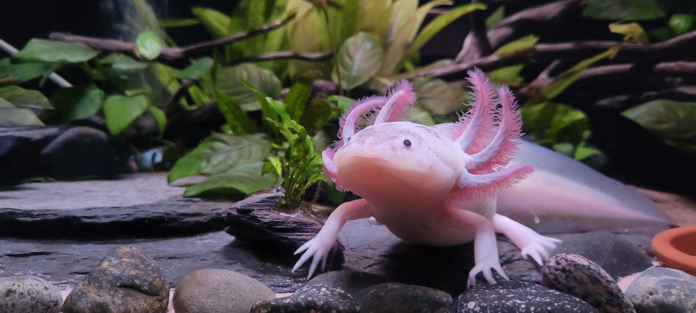By Sophia Byl
In the saga of strange aquatic creatures with biomedical abilities waiting to be discovered, the axolotl is unique in that it never fully reaches adulthood. It can’t produce the thyroid-stimulating hormone that would then let the thyroid produce metamorphosis hormones, meaning that it lives its life in a perpetual juvenile state. But discovering the secret to eternal youth isn’t the only wild biological achievement the axolotl has to its name. Perhaps even more impressive is its ability to regrow lost body tissues, limbs, and entire organs. It can replace a damaged leg with a brand-new, fully functional one in as little as a month with nothing but stem cells and its own amphibious willpower, or regenerate neurons, something that most mammals are not naturally capable of. Taking a page out of the axolotl’s book could help modern medicine leap forwards in terms of efficiently healing larger injuries, internal and external.
The pressing question is, of course, how exactly the axolotl goes about casually regrowing large chunks of itself. The answer lies in stem cells–unspecialized cells that can consequently transform into any cell in the body. Scientists at the Research Institute of Molecular Pathology observed an axolotl regenerate part of its tail after it was amputated and noted that stem cell division tripled in speed near the injury, differentiating into neurons and leaving no traces of damage. Signals sent out by the active stem cells were thought to have subsequently activated even more cells, resulting in tremendous numbers of cells hopping on the tissue-rebuilding bandwagon. However, it’s not just the transformative stem cells that fuel the regeneration process in axolotls–macrophages, as discovered by a study at the Australian Regenerative Medicine Institute (ARMI), are just as necessary. When macrophages were absent, the axolotls weren’t able to regrow limbs . Instead, scars appeared on the tissue, and no effective healing occurred. As for how exactly the macrophages contribute to regeneration is still being researched, but once scientists discover the method to the axolotls’ madness, we’ll be able to apply that to medicine for other living organisms. As Dr. James Godwin from ARMI phrased it, “We need to know exactly what salamanders do and how they do it well, so we can reverse-engineer that into human therapies.”
The types of human therapies in question could range from neural regeneration to organ healing to cancer therapy. Axolotls themselves have shown a hardy resistance to cancer; this makes them model organisms for studying and developing novel regeneration methods in humans. The fact that axolotls can regrow neurons opens a path into curing Alzheimer’s disease, for instance, since Alzheimer’s is caused by dying neurons taking memory and thinking processes with them. ARMI scientists hope that the scar-free healing that axolotls undergo will translate into safer recoveries for surgical patients as well, whether that surgery may be to adjust problems in the heart, liver, or brain. Plus, if we adopt the process used by the axolotl’s stem cells, rather than the cells themselves, we manage to weave around a controversial ethical conversation. Stem cell use in the medical field has been a running issue for a while now due to having to take them from exterior sources (such as human fetuses), but reverse-engineering just the biological regeneration process into humans would help avoid that problem entirely.

